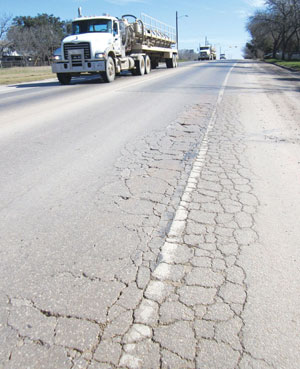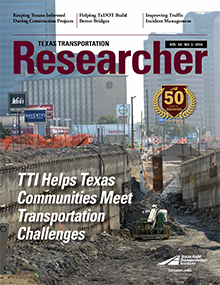Oil and gas production has increased dramatically in Texas in recent years, and every indication is that this trend will continue into the foreseeable future. The state now has 48 percent of all active drilling rigs in the United States. Many of these rigs are in the Eagle Ford Shale play in South Texas. Recent estimates suggest that this play could soon become the most productive in the country. Drilling and production activity is also high in other parts of the state.

The energy boom has had a huge, positive economic impact. However, developing wells requires shipping lots of heavy equipment, materials and products via truck to and from the job site. Many state, county and local roads were not built to sustain the high volume of heavy-truck traffic currently driving on them. The demands on the roads are reducing the life of valuable transportation infrastructure, resulting in the degradation of pavements and other infrastructure such as shoulders, clear zones, driveways and drainage structures.
Danny Magee, director of transportation operations for the Texas Department of Transportation’s (TxDOT’s) Laredo District, says, “In terms of the heavy-truck traffic these roads are seeing, it takes the equivalent of 8 million passenger vehicles to set up one oil well. Then, 2 million vehicles per year just to maintain production on that particular well. A lot of these wells are built on ranches that are off farm-to-market roads that were never built to sustain that volume of traffic.”
The Texas A&M Transportation Institute (TTI) has been working with divisions and districts of TxDOT to understand the patterns and impacts associated with heavy loads on roadway structures. The Institute is also providing recommendations on how to design and maintain roadways into the future.
TTI Senior Research Engineer Cesar Quiroga says TxDOT districts, as well as counties and cities, want to take a more proactive approach — before construction starts on an oil or gas well — by building more lead time into a project to allow them to better prepare for the upcoming demand on roads.
“If we can forecast where energy developments will take place over the next year or two and predict what kind of truck traffic will happen in terms of the number of trucks, routes and wheel loads, we will be in a much better position to anticipate the impact on the roadway system and prepare proactively,” he says. “This kind of information will help everybody: TxDOT, counties, cities and the energy industry. Just as importantly, the citizens of the state will benefit.”
This need has spurred the Comprehensive Transportation and Energy Systems Initiative at TTI, which will take a multidimensional, multidisciplinary approach to developing a framework to address critical transportation needs in all areas where energy developments interact with the transportation system. In the short term, the initiative will involve meeting with stakeholders and preparing a strategic research plan to include, among other strategies, public outreach; improvement of pavement structures; operations and safety; and roadway, environment and design improvements.
“Everything is connected,” says Quiroga. “We need to identify needs where better practices can result in more sustainable developments and more effective management of the transportation infrastructure. Good roadway conditions also mean lower overall operating costs for all users of the road.”
Texas researchers are also learning from other states. The American Society of Civil Engineers (ASCE) recently hosted its first-ever Shale Energy Engineering Conference. TTI researchers played a prominent role in the conference by helping to organize and manage the infrastructure track. Attendees had the opportunity to hear what other states experiencing similar energy booms are doing not just to mitigate damage from the increased truck traffic, but also to develop and implement technologies and better coordination practices.
“While Texas is a dominant player in energy development, we don’t know everything,” says Quiroga. “The ASCE conference gave us a unique opportunity to learn from each other and to identify areas of synergy and future collaboration — a win-win for all participants.”

